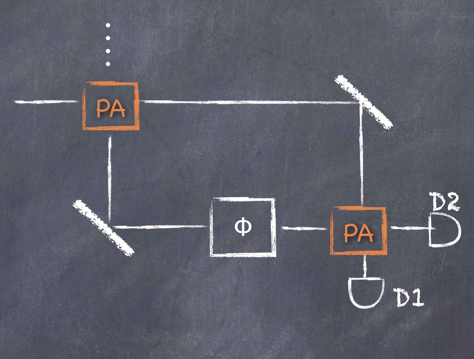Nonclassical Interferometry

Scheme of a non linear interferomter, where the beam splitters are replaced by parametric amplifiers
Description
The quest for the fundamental limit of interferometric measurements has been mainly promoted by the international effort aimed to detect gravitational waves by means of long-arm interferometers. In a classical interferometer, where beam-splitters divide and recombine the beams, the shot noise of the coherent states of the input light is responsible for a phase sensitivity limit that scales with the inverse of the square root of the average number of photons at the input, 1/N1/2. In fact, quantum theory of measurement permits to reach a sensitivity that scales much faster, as 1/N (Heisenberg limit). To reach this limit it is necessary to inject genuine quantum states of light in the interferometer. Alternatively, configurations of ‘nonlinear’ interferometers have been proposed, where beam-splitters are replaced with parametric amplifiers. Indeed, a parametric amplifier can be seen as a four-port device which transforms two input states in a couple of strongly correlated amplified output beams. The correlations led to a significant reduction of the final noise, after recombination of the beams on a conventional beam splitter and homodyne detection. In our case, the practical realization of a parametric amplifier is given by an optical parametric oscillator. The initial input states are a classical coherent state in one port and a vacuum state in the other port. In this configuration, we expect the interferometer sensitivity to remarkably surpass the shot noise limit.
INO Staff
Ricciardi Iolanda (Contact Person)
